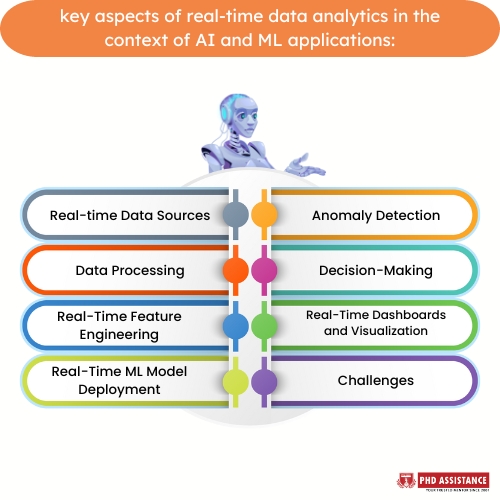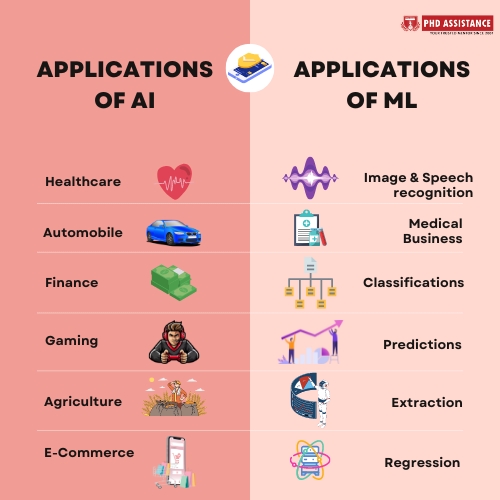Exploring Real-Time Data Analytics for AI & ML Applications
Introduction
Data Analytics is the keystone of transformative technologies like Artificial Intelligence (AI) and Machine Learning (ML). In the realm of AI and ML applications, data-driven insights empower businesses and researchers to make informed decisions, unravel patterns, and predict future trends. This interdisciplinary field marries statistical expertise with advanced computational techniques to extract meaningful information from vast and complex datasets. By harnessing the power of data, organizations can optimize operations, enhance customer experiences, and drive innovation. This blog provides the dynamic landscape of Data Analytics for AI & ML, where we explore the synergy between data, algorithms, and groundbreaking applications.

What is real-time data analytics?
Real-time data analytics analyses data as it’s generated or received, providing immediate insights and actionable information. Unlike traditional batch processing, which deals with data in fixed intervals, real-time data source analytics operate on a continuous data stream. This approach enables businesses to respond swiftly to changing conditions, detect anomalies, and make informed decisions at the moment. By leveraging advanced technologies like streaming data platforms, complex event processing, and machine learning algorithms, real-time data analytics examples are essential in various domains, such as finance, healthcare, IoT, and online services, where timely and precise information can drive critical outcomes.
Key aspects of real-time data analytics
Real-time data analytics plays a critical role in AI (Artificial Intelligence) and ML (Machine Learning) applications, enabling organizations to make timely, data-driven decisions and achieve better performance. Let’s explore the key aspects of real-time data analytics in the context of AI and ML applications:
- Real-time Data Sources:
- Streaming Data: This includes big data analytics in healthcare from sources like IoT devices, social media feeds, clickstreams, sensor data, etc. It’s essential to handle and analyze data as it arrives to derive immediate insights.
- Data Processing:
- In-Memory Computing: Real-time analytics often requires processing big data analytics services in memory rather than on disk to achieve low-latency processing.
- Distributed Computing: Scalable frameworks such as Apache Spark and Apache Flink are commonly used for processing large-scale real-time data.
- Real-Time Feature Engineering:
- Feature Extraction: Real-time analytics can involve extracting features from incoming data streams to be used as inputs for AI/ML models.
- Feature Transformation: Converting raw data research designs into suitable formats for ML models, such as one-hot encoding or normalization.
- Real-Time ML Model Deployment:
- Model Serving: AI/ML models need to be deployed in a way that they can make predictions on incoming real-time data streams without significant delay.
- Model Scaling: Ensuring that the deployed models can handle the high throughput demands of real-time data.
- Anomaly Detection:
- Real-Time Monitoring: Detecting anomalies or unusual patterns in real-time data streams is crucial for early intervention and maintaining system integrity.
- Decision-Making:
- Automated Decisions: Real-time analytics can be used to make automated decisions based on incoming data, reducing the need for manual intervention.
- Real-Time Dashboards and Visualization:
- Real-Time Insights: Displaying real-time analytics results through interactive dashboards and visualizations to aid in quick decision-making.
- Challenges:
- Latency: Achieving low-latency processing is challenging, especially when dealing with massive data streams.
- Scalability: Ensuring that the infrastructure can handle the increasing volume of data.
- Model Drift: Continuously monitoring and updating ML models to handle evolving data patterns.
- Data Quality: Maintaining data quality in real-time environments can be complex.
Real-time data analytics is a fundamental component of AI and ML applications, enabling organizations to harness the power of data for immediate insights and decision-making. It involves handling PhD in data analytics as it arrives, processing it efficiently, deploying ML models in real-time, and addressing latency, scalability, and data quality challenges.
- Check out our sample PhD Data Analytics examples to see how PhD Data Analytics is developed.
A brief overview of AI and machine learning in big data analytics: applications, problems, and future prospects

The integration of AI and machine learning in big data analytics has revolutionized various industries. These technologies empower organizations to extract valuable insights from massive datasets, uncover hidden patterns, and enhance decision-making. Applications range from predictive analysis and customer behaviour modelling to personalized recommendations and fraud detection. However, this synergy brings forth challenges like data privacy, algorithm bias, and the need for skilled professionals. Despite these hurdles, the prospects are promising. As the latest artificial intelligence applications continue to advance, it has the potential to transform how we process, interpret, and leverage big data analytics in healthcare, driving innovation, efficiency, and competitiveness in the digital age.
- Check out our study guide to learn more about How can AI and ML improve your data analytics workflow?
Conclusion
In the realm of AI and ML applications, real-time data analytics stands as the catalyst for rapid, data-driven decisions. Organizations gain a competitive edge by harnessing streaming data, enabling in-memory computer programming, and deploying models for instantaneous predictions. Despite challenges like latency and data quality, real-time analytics empower anomaly detection, automated decision-making, and real-time visualization, fueling effective monitoring and applications of big data analytics. In this dynamic landscape, embracing real-time analytics isn’t just a choice; it’s necessary to unlock the true potential of AI and ML, ensuring agility, efficiency, and staying ahead in an ever-evolving data-driven world.
About PhD Assistance
At PhD Assistance, we evaluate data important to the thesis and ensure that you fully comprehend the outcome. Aside from that, Ph. D professionals will discuss your findings for and against the literature review. Our expert and experienced team members are highly knowledgeable in many research topics and have successfully managed these issues several times during the dissertation creation process for countless PhD candidates.
References
- Maganathan, Tharsanee, Soundariya Senthilkumar, and Vishnupriya Balakrishnan. “Machine learning and data analytics for environmental science: a review, prospects and challenges.” IOP Conference Series: Materials Science and Engineering. Vol. 955. No. 1. IOP Publishing, 2020. DOI1088/1757-899X/955/1/012107
- Chen, Weisi, et al. “Real-Time Analytics: Concepts, Architectures and ML/AI Considerations.” IEEE Access(2023).
- Womble, David E., et al. “Early experiences on the summit: Data analytics and AI applications.” IBM Journal of Research and Development6 (2019): 2-1.



